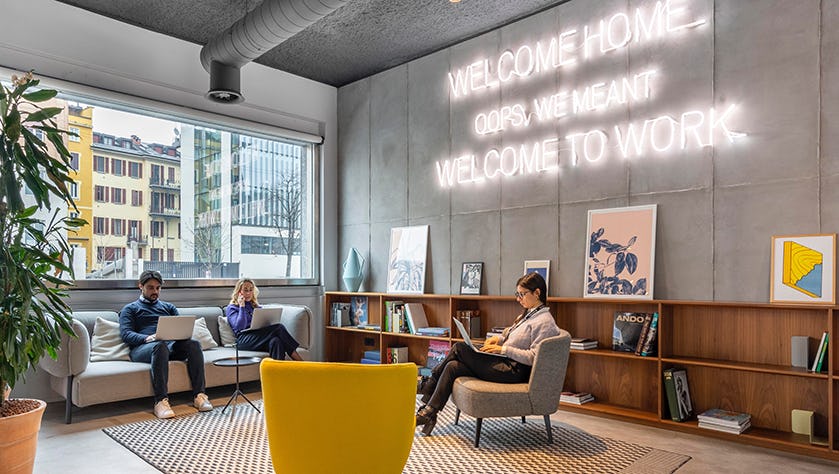
Blue for creativity, red for performance – we look at the different ways to switch up your workspace to inspire the imagination
Last year, much of the corporate world had to pivot from being office-based to working from home. Productivity may have gone up or down depending on which study you read, but what about creativity?
It’s perhaps no surprise to learn that spending hours looking at the same four walls is not conducive to sparking great business ideas. And when the world’s workers start to return to the office (when it’s safe to do so, of course), companies will start to realise that their environment could be the thing to reignite creativity in both employees and the organisation.
Few understand this as well as Spaces, which has been offering creative workspaces to its customers for the last 12 years. “Our brand is as strong a brand as Apple,” says Maarten Jamin, Chief Design Officer of Spaces. “There’s no Chinese Apple or European Apple, there’s just one Apple with a brand identity secure enough for everybody to appreciate it. It’s the identity of Spaces that people buy into: the community feel, the connection we have between the different cities and countries. Our brand identity is a very strong asset for us.”
Below, we explore the science behind great office design – and how Spaces is harnessing them in its centres.
Chaotic good
While there are many benefits to working from home, such as a lack of commute and fewer distractions, it can also have a detrimental effect on our creativity. A recent feature in the Financial Times suggests that it’s the mindful distractions of a boring commute or a buzzy, ambient office that actually benefit the creative process.
While natural lighting, ambient noise and bright colours will boost our creative thinking, a study by Kathleen D. Vohs, a marketing professor from the University of Minnesota Carlson School of Management, suggests working at an untidy desk can inspire creativity. It’s all about breaking away from order and convention. Working amongst chaos turns traditional norms on their head and helps people think outside the box.
Where your office is based can stimulate the senses, too. Spaces Napa Valley is an exciting new location in downtown Napa, just north of San Francisco. An innovative new development surrounded by boutiques, shops, restaurants and wineries, it’s a place where customers can work and enjoy life in harmony.
Creativity is a different kind of thinking
It’s not just artists and musicians who are inspired by their surroundings, those who work in the creative industries are also stimulated by what they see, hear and feel. Our physical environment has a significant effect on our imagination, which is why big tech HQs such as those of Google, Apple and Facebook all have bright, colourful offices with quirky features like vintage subway cars, climbing walls and secret revolving bookcases.
These features are not just eccentric for eccentricity’s sake, there’s science at work: they are intricately designed to stimulate creativity at every turn.
The science behind colour
Research by the University of British Columbia has shown that the colours of our environment can have an immediate effect on our productivity and creativity. Blue helps us think creatively and outside the box, while red boosts performance and productivity. Colours can also evoke different moods – yellow will increase energy, while greens and pale blues will help us feel calmer and more in control.
At Spaces, colour is used not just to stimulate the senses, but also to reflect the location and values of each centre. “When we designed our first Spaces, the dream was that they’d all be different and unique,” says Jamin. Today, Spaces gives designers a guide that covers up to 80% of what they need to do – leaving the other 20% up to them. “This frees up a lot of time for them to make the design suit the building,” explains Jamin. “Each site has its own identity, taken from the building, the surroundings and the people visiting it.”
Encouraging creativity in the office
There are various different factors to consider when it comes to fostering creativity in the workplace. Our brains are stimulated by what we see and how it makes us feel, and working in a familiar territory can help put employees in their comfort zone, which is why some folk bring in photos, trinkets, and healthy air-cleansing plants from home to decorate their desks.
Natural light is also very important as it contains blue light, which has been proven to boost our immune systems, increase dopamine levels and lower stress, all of which make us productive and more imaginative. Simply changing the office around can spark our creative synapses into action, while a brightly coloured space can create a visual interest which can make employees feel more playful and be adventurous with their ideas. Maybe consider having a drawing wall like Reebok, where all employees can brainstorm the brand’s latest designs by writing on the walls.
Silence is not always golden
It’s not just décor that can inspire: the atmosphere of an office can also have an effect on our ability to think creatively. While some people can work well in a quiet office, others might need the clamour and noise of a busy open space to think up their best ideas, which is why co-working areas and shared offices, plus breakout rooms and casual meeting areas make space and allowances for everyone.
“It’s the energy of the other users that makes a Spaces environment so positive,” says Jamin. “Our community managers are there to connect those users together and create a synergy between them, and that’s something unique to the flexible workspace environment.”
We don’t all need the indoor slides, climbing walls and games rooms of Silicon Valley. Find out how Spaces’ dynamic co-working offices can help inspire your team to be more creative
Share this article
 Read now How to be a more human colleague in a virtual world
Read now How to be a more human colleague in a virtual world
 Read now Five technologies that will transform the way we work in 2021 – and beyond
Read now Five technologies that will transform the way we work in 2021 – and beyond